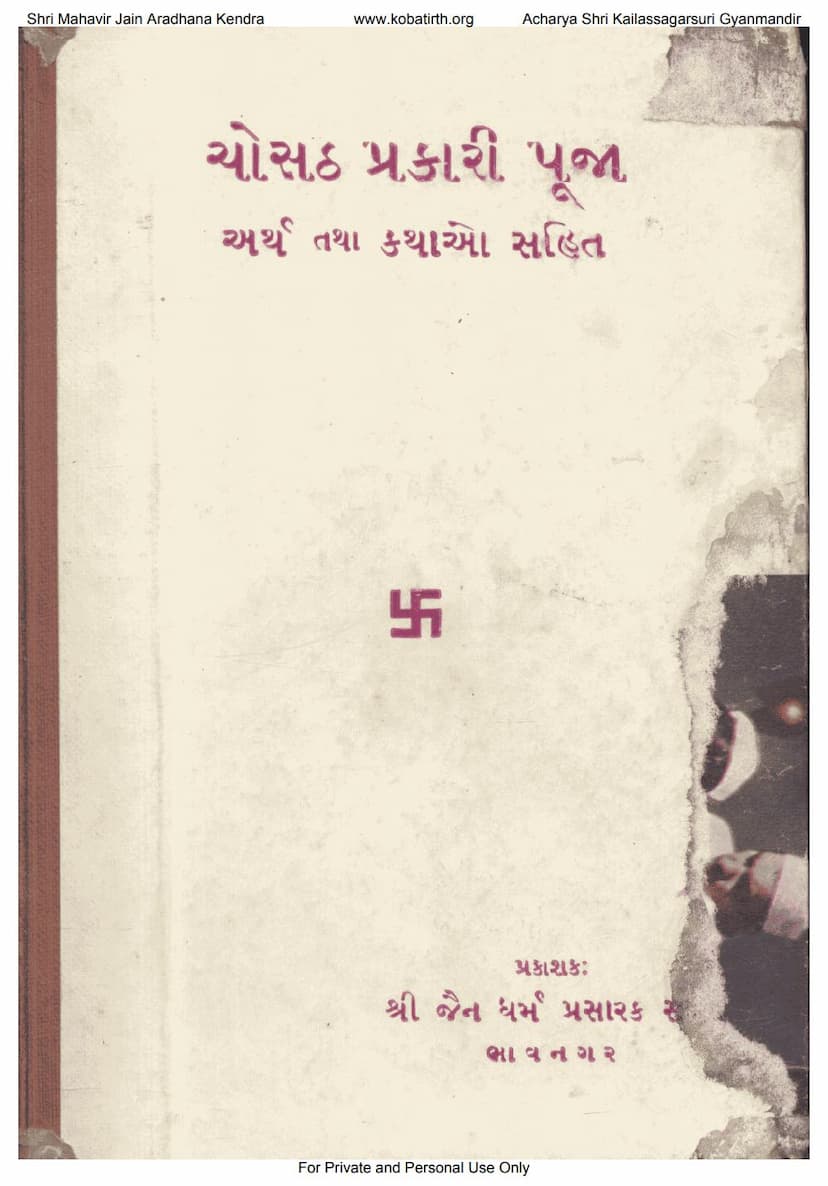Chosath Prakari Pooja Arth Evam Katha Sathe
Added to library: September 1, 2025

Summary
Here's a comprehensive summary of the Jain text "Chosath Prakari Pooja Arth Evam Katha Sathe" (Sixty-Four Types of Worship with Meaning and Stories), authored by Veervijay and published by Shri Jain Dharm Prasarak Sabha, Bhavnagar:
Overall Purpose and Content:
This book is a comprehensive guide to performing the "Sixty-Four Types of Worship" (Chosath Prakari Pooja) within Jainism. It aims to provide the reader with not only the ritualistic steps but also the deeper meaning (artha) and associated narratives (katha) behind each form of worship. The text emphasizes the spiritual significance of these rituals, particularly as they relate to understanding and overcoming the eight types of karmas that bind the soul.
Key Components and Structure:
The book is structured into three main sections:
-
Volume 1: Chosath Prakari Pooja Arth Sahit (Sixty-Four Types of Worship with Meaning): This is the core of the book, detailing 64 different types of worship, each dedicated to the purification or removal of specific karmas.
- Eight Karmas: The worship is organized around the eight karmas in Jain philosophy: Jnanavarniya (knowledge-obscuring), Darshanavarniya (perception-obscuring), Vedaniya (feeling), Mohaniya (delusion), Ayushya (lifespan), Nama (body-making), Gotra (status), and Antaraya (obstacle).
- Eight Pujas per Karma: For each of the eight karmas, there are eight distinct types of worship, totaling 64. These pujas utilize various offerings like water (Jal), sandalwood (Chandan), flowers (Pushpa), incense (Dhoop), lamp (Deep), unbroken rice (Akshat), food offerings (Naivedya), and fruits (Phal). Each offering has a specific symbolic meaning related to the karma being addressed.
- Kalsah (Pot) Worship: In addition to the 64 karmas, the book includes worship of the "Kalash" (sacred pot), symbolizing auspiciousness and the attainment of the soul's inherent purity.
- Karmasudan Tap Vidhi: The text also provides details on the "Karmasudan Tap" (Karma-destroying asceticism), a specific spiritual practice likely related to the underlying philosophy of these pujas.
-
Volume 2: Katha Sangrah (Collection of Stories): This section compiles 25 influential stories that illustrate the principles and benefits of the karmic purification through worship. These stories are drawn from various Jain scriptures and narratives, providing practical examples of how devotion and adherence to dharma lead to the overcoming of karmic obstacles. The stories are often linked to specific karmas or types of worship, making the abstract concepts more tangible.
-
Volume 3: Shri Parshwanath Panchkalyanak Pooja (Worship of the Five Auspicious Events of Lord Parshvanath): This section focuses on the worship dedicated to the five auspicious events in the life of Lord Parshvanath: Chyavana (descent into the womb), Janma (birth), Diksha (renunciation), Kevala Jnana (omniscience), and Nirvana (liberation). Each of these Kalyanakas is accompanied by specific pujas.
Author and Publisher:
- Author: Pandit Veervijay Ji (a respected Jain scholar).
- Publisher: Shri Jain Dharm Prasarak Sabha, Bhavnagar. This indicates the book's origin and its purpose in propagating Jain principles.
- Editions: The book went through multiple editions, with the third edition being published in Vikram Samvat 2011 (1955 CE) and Veer Samvat 2481. This suggests its enduring popularity and importance in the Jain community.
Philosophical and Practical Significance:
- Karma Theory: The entire framework of the Chosath Prakari Pooja is rooted in the Jain theory of karma. Each puja is designed to counteract or purify the influence of specific karmas.
- Devotion and Faith: The book highlights the importance of "Dravya Pooja" (worship with material offerings) combined with "Bhava Pooja" (internal devotion and understanding).
- Ethical Teachings: The accompanying stories serve as moral exemplars, teaching about virtues like righteousness, detachment, perseverance, and the consequences of negative actions.
- Spiritual Progress: The ultimate goal of these practices is described as attaining liberation (Moksha) and the state of the Siddhas, characterized by eternal bliss and freedom from karmic bondage.
- Practical Guide: Beyond the spiritual philosophy, the book acts as a practical manual for Jain devotees, guiding them on how to perform these intricate rituals with devotion and understanding.
Key Themes and Symbolism:
- Purity: Water (Jal) in pujas symbolizes purification, washing away karmic impurities.
- Knowledge and Enlightenment: Offerings like lamps (Deep) symbolize the dispelling of ignorance and the attainment of divine knowledge.
- Auspiciousness: Fruits, flowers, and unbroken rice (Akshat) symbolize prosperity, auspiciousness, and the unbroken spiritual path.
- Detachment: The emphasis on overcoming desires and attachments, particularly those leading to negative karmas, is evident throughout the text.
In essence, "Chosath Prakari Pooja Arth Evam Katha Sathe" is a devotional and educational text that deeply integrates Jain philosophy, particularly the doctrine of karma, with practical ritualistic practices. It uses compelling narratives to illustrate the spiritual path, making the pursuit of liberation a more accessible and meaningful journey for its readers.